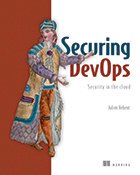The 3 pillars of a DevSecOps model
1.3.1 Test-driven security
 Click to learn more about this book.
Click to learn more about this book.
Enter “Techtarget40” at checkout,
and receive a 40% discount on this title.
The myth of attackers breaking through layers of firewalls or decoding encryption with their smartphones makes for great movies, but poor real-world examples. In most cases, attackers go for easy targets: web frameworks with security vulnerabilities, out-of-date systems, administration pages open to the internet with guessable passwords, and security credentials mistakenly leaked in open source code are all popular candidates.
Our first goal in implementing a continuous security strategy is to take care of the baseline: apply elementary sets of controls on the application and infrastructure of the organization and test them continuously. For example:
- SSH root login must be disabled on all systems.
- Systems and applications must be patched to the latest available version within 30 days of its release.
- Web applications must use HTTPS, never HTTP.
- Secrets and credentials must not be stored with application code, but handled separately in a vault accessible only to operators.
- Administration interfaces must be protected behind a VPN.
The list of security best practices should be established between the security team and the developers and operators to make sure everyone agrees on their value. A list of baseline requirements can be rapidly assembled Application security
Modern web applications are exposed to a wide range of attacks. The Open Web Application Security Project (OWASP) ranks the most common attacks in a top-10 list published every three years: cross-site scripting, SQL injections, cross-site request forgery, brute-force attacks, and so on, seemingly endlessly. Thankfully, each attack vector can be covered using the right security controls in the right places. In chapter 3, which covers application security, we’ll take a closer look at the controls a DevOps team should implement to keep web applications safe.
Infrastructure security
Relying on IaaS to run software doesn’t exempt a DevOps team from caring about infrastructure security. All systems have entry points that grant elevated privileges, like VPNs, SSH gateways, or administration panels. When an organization grows, special care must be taken to continuously protect the systems and networks while opening new accesses and integrating more pieces together.
Pipeline security
The DevOps way of shipping products through automation is vastly different from traditional operations most security teams are used to. Compromising a CI/CD pipeline can grant an attacker full control over the software that runs in production. Securing the automated steps taken to deliver code to production systems can be done using integrity controls like commit or container signing. I’ll explain how to add trust to the CI/CD pipeline and guarantee the integrity of the code that runs in production.
Testing continuously
In each of the three areas I just defined, the security controls implemented remain fairly simple to apply in isolation. The difficulty comes from testing and implementing them everywhere and all the time. This is where test-driven security comes in. TDS is a similar approach to test-driven development (TDD), which recommends developers write tests that represent the desired behavior first, and then write the code that implements the tests. TDS proposes to write security tests first, representing the expected state, and then implement the controls that pass the tests.
In a traditional environment, implementing TDS is difficult because tests must run on systems that live for years. But in DevOps, every change to the software or infrastructure goes through the CI/CD pipeline and is a perfect place to implement TDS, as shown in figure 1.5.
The TDS approach brings several benefits:
- Writing tests forces security engineers to clarify and document expectations. Engineers can build products with the full knowledge of the required controls rather than catching up post-implementation.
- Controls must be small, specific units that are easy to test. Vague requirements such as “encrypt network communication” are avoided; instead, we use the explicit “enforce HTTPS with ciphers X, Y, and Z on all traffic,” which clearly states what’s expected.
- Reusability of the tests across products is high, as most products and services share the same base infrastructure. Once a set of baseline tests is written, the security team can focus on more-complex tasks.
- Missing security controls are detected prior to deployment, giving developers and operators an opportunity to fix the issues before putting customers at risk.
Tests in the TDS approach will fail initially. This is expected to verify their correctness once they pass, after the feature is implemented. At first, security teams should help developers and operators implement controls in their software and infrastructure, taking each test one An important part of TDS is to treat security as a feature of the product. This is achieved TDS adopts the DevOps principles of automating the pipeline and working closely with teams. It forces security folks to build and test security controls within the environments adopted Click here to read Chapter 1.
Learn more about Manning Publications.
